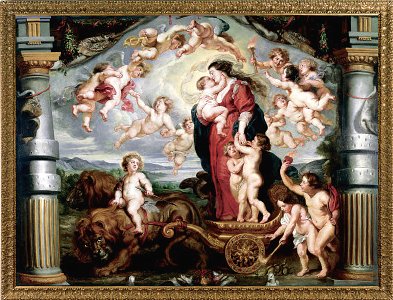 |
|
The Triumph of Divine Love
by Peter Paul Rubens, Flemish 1577-1640
SN 977 Oil on Canvas c.1625
Robert Anderson. 2000
Artist:
Peter Paul Rubens, along with the Italian sculptor Gianlorenzo Bernini, was one of the
greatest artists of the 17th century. His canvases can be said to define the scope and
style of high baroque painting through their energy, earthy humanity and inventiveness. A
devoutly religious man, a man of learning and a connoisseur of art and antiquities, he was
also a man of the world who succeeded not only as an artist but as a respected diplomat in
the service of Isabella and Albrecht of the Spanish Netherlands. |
Travels to Venice where he studied Titian, Veronese & Tintoretto freed
his artistic talent from rigid classicism. While he did incorporate copies of classical
statues in his paintings he always avoided the appearance and coldness of stone. To the
contrary, his nudes, for which he became famous, always depicted an ample female form of
vitality and good health as well as of sensuousness. His mastery of color along with his
knowledge of antiquity is seen particularly in his mythological paintings.
As court painter and confidant to the Archduchess Isabella Clara Eugenia,
Rubens recognized the role art was to play in the Counter Reformation. His genius found
expression in his designs for the Triumph of the Eucharist tapestries which he and his
assistants completed between 1625 and 1628.
Knighted by two monarchs and master of a successful workshop, Rubens
became rich and famous in his own time. Having executed over 3,000 paintings, woodcuts and
engravings of all types, he died the most respected artist of his time in 1640.
Subject:
This picture is allegorical in that it contains a grandiose procession which celebrates a
victory - the defeat of evil in the world by religious or divine love. This divine love is
personified by Charity, who is the foremost of the three 'theological virtues' and who in
this painting resembles the Virgin Mary. Charity is linked to the classical Mother of the
Gods, Cybele, by the two lions who pull her chariot. In this implied reference Charity, as
Mother of the Gods is seen as Mary, the Mother of God. A reference is made to Christ's
sacrifice for the world by depicting the pelican piercing her breast in order to feed her
young. Snakes represent evil and are overcome by the religious ardor of the flaming heart
and the arrows of sacred love.
Painting:
Caritas or Charity stands on a small chariot drawn by two lions. She holds one of her
children in a tender embrace while two others stand by her side. In front of her stands a
pelican, piercing her breast to feed its young. In the air around her fly twelve (12)
putti, one of whom holds a flaming torch. On the ground are three more putti. One rides a
lion with an arrow in his hand; one stoops to burn two intertwined snakes; the third
raises a flaming heart in one hand and a bow in the other. These motifs of love ( sacred
and profane) are repeated in various decorative elements. In the center of the chariot's
wheel is a carved seraph from which radiate alternating arrows and shafts of flame as
spokes.
A garland of fruit and flowers is strung above the tapestry which is hung
between two doric columns. In the center between two crossed torches hangs a cartouche
inscribed "Amor Divinus" . Below the bottom ledge, in the center, is placed a
flaming heart pierced by two crossed arrows encased in an ornamental shell adorned with
flowers. On each side is a cornucopia from which emerge flames and smoke and on which sits
a dove, another emblem of love.
While members of Ruben's workshop painted much of the final cartoon we can
discern Ruben's own hand in the painting of the face of the putto riding the lion.
Historical Context:
The cycle of eleven paintings of The Triumph of the Eucharist was commissioned by the
Archduchess Isabella who was the daughter of Philip II of Spain and the Governor of the
Spanish Netherlands. It was planned as a gift for the convent of the Descalzas Reales in
Madrid in 1625 where it still hangs today. This Franciscan Order of Poor Clares was one
with which Isabella was closely associated.
The series is a mixture of allegory and religious propaganda intended to
promote the worship of the Eucharist (ie the bread and wine consecrated as the body and
blood of Christ and distributed at communion) which had been strengthened recently by the
Council of Trent and which constituted an important element in Counter Reformation
Catholicism.
This was a time of great concern on the part of the Catholic church as it
attempted to correct not only the abuses of the clergy but also to reaffirm its tenets /
dogma in the face of attacks by the Protestant Reformation.
ringlingdocents.org
|
